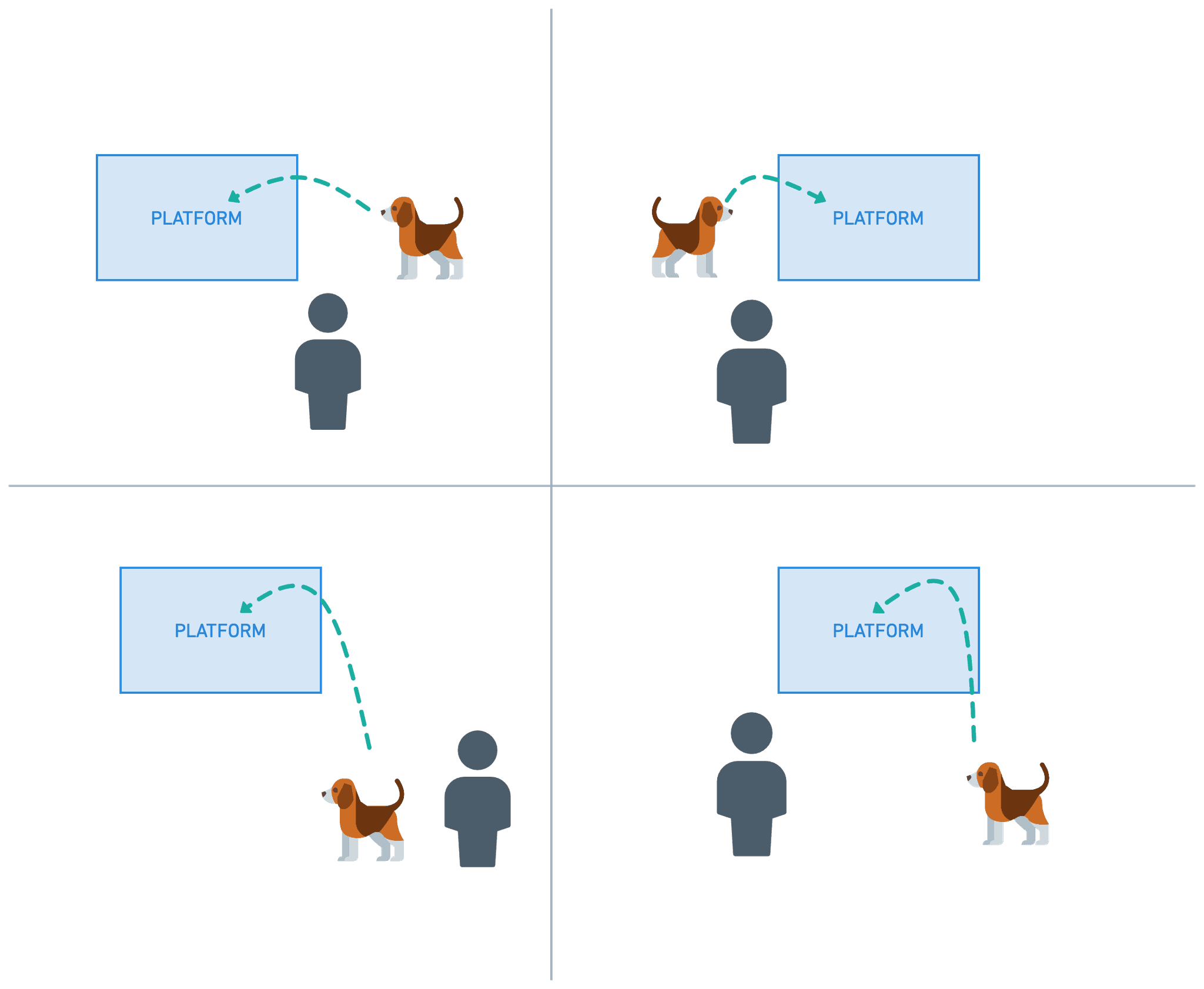Now that your dog understands how to get rewards, how to follow a lure, and how to respond to the leash, we're ready to teach a new command: "place." Teaching a brand new command happens in three phases: Perform, Pair, and Proof. This is a formula for learning that you'll use every time you want to teach them a new command.
Before we start: Why the "place" command?
Telling your dog to go to a spot and stay there (we'll work on the "stay" part in lesson 5) is more than just a trick. It's the most amazing, multi-purpose behavior management tool ever!
Barking at the door? Place.
Annoying the other dog? Place.
Stealing your socks as you fold the laundry? Place.
Tripping over them in the kitchen while you cook? Place.
The place command, tells them what you want them to do instead of whatever they're doing. This makes it so much more effective than just saying no or just interrupting the behavior. It's especially great for overstimulated dogs who just need to go to a spot and settle down for a few minutes.
Phase 1: Perform the Action
The first thing we're going to do is use a combination of luring (lesson 2) and leash guidance (lesson 3) to show them the exact thing we want them to do. Our yes marker (lesson 1) is going to help us pinpoint the behavior we're after.
In this phase we guide them onto the platform, mark & reward, then let them off the platform. We repeat this over and over until they understand the action.
Leash your dog and get ready with that treat bag. Here's what to do:
Stand with your dog close to the platform.
Apply some leash guidance in the direction of the platform.
The moment all 4 paws are on the platform, let the leash go slack, mark ("yes"), and reward.
After a couple seconds say "free" (more on that later) and then guide them off the platform.
Walk around in a quick circle, maybe throw them a little dance party to celebrate.
Within about 5 seconds, get their attention and repeat. Do this 4 or 5 times in a row and then take a little break.
You may spend a few training sessions in this phase. That's great! A very common mistake is to rush into phase 2 too quickly. The more confident they are in performing the action, the stronger the association with the command will be.
TIPS AND TRICKS
☝️
Don't forget you can also use luring to provide extra guidance in phase 1. If you want the "place" command to have an implied "down" then you can lure them into a down as soon as they step up onto the platform. If you're going for this bonus, don't say "down" if you want it to be part of place.
Phase 2: Pair the Action
When your dog is doing this action repeatedly and with confidence, it's time to pair this action with a command. Remember a command is just a queue and it could be anything–a hand signal, a tap on the back, a whistle… anything! In this case we want to use a sound: "place."
While you have their attention, say "place" and then do the entire sequence from phase 1.
You may be saying "place" for a while before they really get it. Don't get frustrated. Not all dogs have a satisfying "aha!" moment in the same way humans often do. Sometimes progress is slow and incremental. Over time they will get it though.
At some point you'll see some movement (or maybe a look) over to the platform when you say "place" even before you start guiding them. That's great! See if they'll do it on their own. If they don't do it within 2 seconds, don't repeat "place." Instead, guide them with the leash and keep at it.
TIPS AND TRICKS
☝️
The biggest mistake people make here is not being precise and clear with their words. Instead of "Place" they say things like "Okay Fido, place." or "Okay, ready? Place. Right over here. Good booooy." Literally, the only sound from your mouth should be "Place" followed immediately with guidance onto the platform. Then "Yes" as soon as all 4 paws are on. Then "free." So it's PLACE… YES… FREE. That's it.
☝️
Make sure you're not pairing the word with the motion of guiding them to the platform. If you do them simultaneously it's much harder for them to learn the word alone.
☝️
If you've been practicing the "Bubble O' Fun!" exercise from lesson 2 a lot, your dog might only want to move when you move. (Lucky! Loose-leash walking is going to be a breeze.) For "velcro dogs" we need to show them that they should move the platform, not wait for us to go there with them. To help with this, situate yourself, your dog, and the platform in a triangle and keep your feet planted using only the leash to get them to move across you and onto the platform as shown in the little illustration from lesson 3.
When you're standing just 1 or 2 steps away from the platform and your dog is hopping onto the platform right after they hear "Place," you'll know you've successfully paired the word with the action! Ready for phase 3.
Phase 3: Proof the Action
At this point your dog is now hopping onto the platform when they hear the words "Place." Now we're going to increase the difficulty just a teeny bit to help them understand that "place" means the same thing no matter the terrain or where you're standing.
Change your position
Before saying "Place," switch up your position. We're teaching your dog that whenever they hear this word, it always means the same thing, no matter where they are or where you are.
Change your location
Dogs can have a difficult time generalizing a skill to different locations. When you feel like your dog is totally getting the command, try moving the platform to a different room. Then try moving it to outside. Now try it in the yard on some grass. Now try it in the garage.
Increase the distance
Now your dog is really getting it. Try asking them to "place" from a little further away from the platform. Increase to from 5 to 10 ft. Now try 15. Now try 20!
Don't be frustrated if your dog "caps out" at a certain distance – especially if it's so far they can't actually see the platform (maybe it's blocked by the couch or something). If they get confused, just take a few literal steps back to a shorter distance.
TIPS AND TRICKS
☝️
Once you're in the proofing phase of teaching a skill, it's tempting to ramp up the difficulty too quickly. If you add a little difficulty and they fail, don't worry! Either take a step back and keep practicing the the skill at a lower level OR guide them over to the platform using luring and/or the leash.
☝️
If they fail, be sure not to repeat the command "place." Repeating the command will only add to their confusion. Instead, after 2 seconds, start guiding them to the platform.




